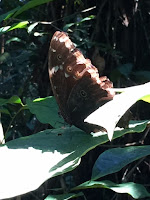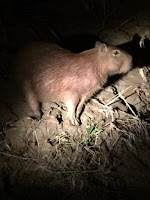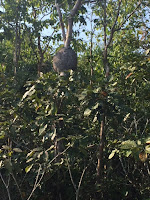Our journey began with a flight to Auckland, and then onto Lima via Santiago. We caught our first glimpse of the magnificent Andes from the plane window. It was early evening and the mountains were stunning - a softly hazy sequence of layers - a bit like the Richmond Ranges in Marlborough, only on a much more majestic scale. We arrived in Lima in the dark and had a long taxi drive to our hotel through busy city traffic. There were glimpses of unfamiliar architecture and varying degrees of wealth displayed - some shabby, some chic areas. 5 hours sleep and back to the airport again.
August 26
We flew (Air Avianca) to Puerto Maldonado, touching down briefly in Cusco en route. Flying into Cusco was reminiscent of flying into Queenstown - very much like landing in a bowl. There were more amazing views of the Andes - snowy peaks above the clouds until we finally descended enough to see the jungle below. Puerto Maldonado has a tiny airport where we were met by our guide, Armande. We had a few moments to take in the small town during the short drive to the Inotawa office. The town was ramshackle and run down in places, but had the cheery vibe that we were soon to become familiar with. The drive to the boat should have taken about 10 minutes, but the volume of the potholes in the road extended this to around 45 very bumpy minutes. The boat was typical of those that navigate the Amazon basin - low to the water, long and narrow, and in need of balancing by the passengers on board. The 1.5-hour boat ride took in White Cayman, yellow-headed vultures, white egrets, night heron, red and green macaws and yellow spotted side neck turtles. It was a great introduction to the abundant wildlife ahead of us. Our accommodation was a small jungle 'lodge'. Windows were replaced with insect mesh, bringing the sights and sounds of the jungle close in. Downstairs was a bed with mosquito net and a bathroom. The bathroom had a great view (both out and in!) through the insect mesh window, but despite having 2 taps, only had cold water. Power was restricted to 3 hours a day - enough to recharge devices - and candles were provided. Upstairs was an open balcony with hammocks and seating. The lodge was surrounded by jungle plants, including stunning flowers, and upstairs was a perfect raised platform to watch wildlife. We watched squirrel monkeys play in nearby trees, and fireflies lit up as dusk approached. We took a walk through the jungle, taking in the trees and plants and millions of very busy butterflies.
Armande took us out for a walk in the dark by torchlight. His knowledge and infectious wildlife enthusiasm became increasingly apparent, and we spotted spiders, scorpion, tree frogs, geckos and red brocket deer. Back at the lodge, dinner was an assortment of local fayre - all of it delicious to me, and most of it even acceptable to Peter.
August 27
August 27
August 28
Yes, up early again and a short boat ride and walk took us to a covered shelter on the opposite bank of the Tambopata with a perfect view of La Torre clay lick. At specific times of day, parrots gather in a nearby tree and then descend en masse to the clay lick. They need the nutrients in the clay to be able to digest otherwise poisonous plants. The birds we witnessed included dusky headed parakeet, orange-cheeked parrot, yellow-crowned parrot, Chestnut-fronted macaw, blue-headed parrot and Mealy parrot. Armande and a fellow guide set up a camera on a tripod, so we were able to get close up photos of these breathtakingly beautiful birds. Armande then took us to a local farm where we could see groves of avocados, bananas (many different varieties), papaya, corn, citrus, star fruit, pineapple, turmeric and of course, cocoa beans. He chopped down a huge bean pod and gently cut it in half with a machete to reveal huge white cocoa beans inside. These beans have a sweet white coating and the bean itself is chocolatey-bitter.
We then went back to the boat and out with the fishing rods. Peter caught catfish - edible and non-edible varieties - and a pacu that he didn't manage to land. In the afternoon was another boat ride and a short walk to Lake Tres Chimbadas. Aboard a catamaran, we went fishing for piranha. Peter used his extendable rod (no, not a euphemism) and I used a bamboo cane with a line tied on. Peter caught several piranhas, and I just caught one, plus a small sardine. My first ever piranha - a very proud moment!! We spotted more giant river otters and Cayman, plus snowy egrets, hoatzin, short-tailed hummingbird and a nightjar. There was an incredible iridescent bee gathering nectar from a local plant. We settled down to watch another stunning sunset. It's a hard life.






































August 29
Up early as usual, a boat ride and a bumpy car ride back to Puerto Maldonado. En route we were entertained by red and blue macaws and green parrots. We said goodbye to Armande and Melo (boat driver/film star: 'Candamo la Ultima Selva sin Hombres') and flew off back over the Amazon to Cusco.


























No comments:
Post a Comment